 Khademite and rostite are rare orthorhombic minerals Al(SO4)F·5H2O and Al(SO4)OH·5H2O, respectively. Libušín is a type locality of rostite but recent studies have only confirmed the presence of khademite. New electron microprobe analyses of khademite from Libušín revealed a fluorine concentration of 8.12–8.18 wt.%, which is the highest ever found for khademite. Precise discrimination of structurally very similar sulfates is of high importance for geochemical studies and a combination of different analytical methods is preferred to reach this goal.
Khademite and rostite are rare orthorhombic minerals Al(SO4)F·5H2O and Al(SO4)OH·5H2O, respectively. Libušín is a type locality of rostite but recent studies have only confirmed the presence of khademite. New electron microprobe analyses of khademite from Libušín revealed a fluorine concentration of 8.12–8.18 wt.%, which is the highest ever found for khademite. Precise discrimination of structurally very similar sulfates is of high importance for geochemical studies and a combination of different analytical methods is preferred to reach this goal.
Košek F., Žáček V., Škoda R., Laufek F., Jehlička J. (2019): New mineralogical data for khademite (orthorhombic Al(SO4)F·5H2O) and the story of rostite (orthorhombic Al(SO4)OH·5H2O) from Libušín near Kladno, the Czech Republic. Journal of Molecular Structure 1175, 208-213. (DOI)









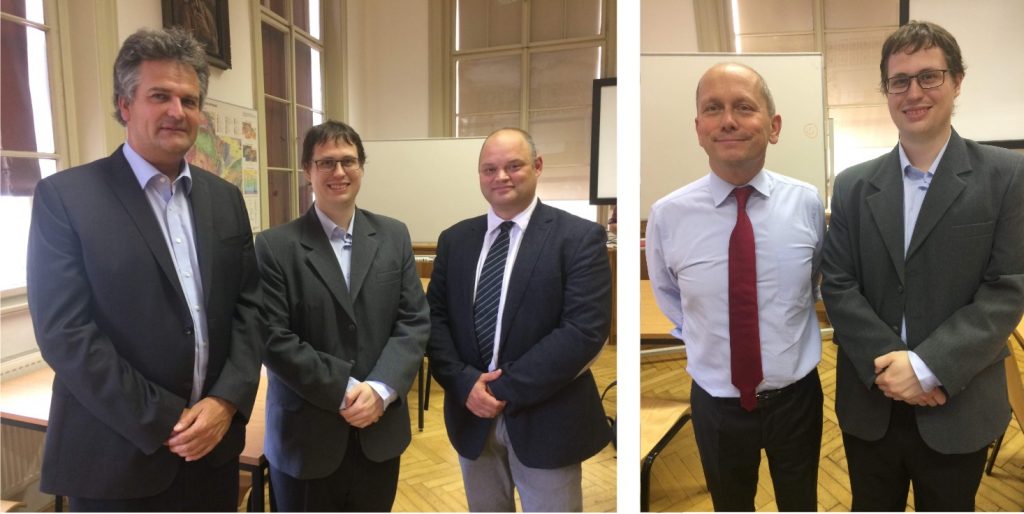 On Friday September 21, 2018, Filip Košek defended his PhD entitled “Application of Raman spectroscopy for detection of sulfates of self-ignited coal heaps“. On the photos you find him together with two reviewers Prof. Ivan Němec from Charles University (left) and Prof. Peter Vandenabeele from Ghent University (Belgium) and his supervisor, Prof. Jan Jehlička. Congratulations!
On Friday September 21, 2018, Filip Košek defended his PhD entitled “Application of Raman spectroscopy for detection of sulfates of self-ignited coal heaps“. On the photos you find him together with two reviewers Prof. Ivan Němec from Charles University (left) and Prof. Peter Vandenabeele from Ghent University (Belgium) and his supervisor, Prof. Jan Jehlička. Congratulations!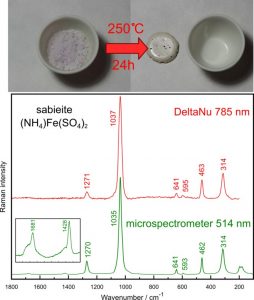 New molecular data on exotic phases mineral occurring in fumarolic systems are reported in this paper. Fumaroles, vents that emit hot gases and vapor, are accompanying phenomena of volcanic activity. Such phenomena are also observed within the framework of self-ignited burning coal seams and coal heap. Rare anhydrous sulfates (millosevichite, mikasaite, efremovite, godovikovite, sabieite, and steklite) are signature minerals of such encrustations. Six synthetic anhydrous sulfates were prepared from the hydrated analogues, and were investigated using both a bench-top Raman microspectrometer and a portable Raman spectrometer. This comparative approach can help further steps for the successful deployments of miniature Raman tools in situ under field conditions. New measurements show that the performance of a light-weight portable Raman spectrometer with near infrared excitation was sufficient for the unambiguous discrimination of the investigated sulfates.
New molecular data on exotic phases mineral occurring in fumarolic systems are reported in this paper. Fumaroles, vents that emit hot gases and vapor, are accompanying phenomena of volcanic activity. Such phenomena are also observed within the framework of self-ignited burning coal seams and coal heap. Rare anhydrous sulfates (millosevichite, mikasaite, efremovite, godovikovite, sabieite, and steklite) are signature minerals of such encrustations. Six synthetic anhydrous sulfates were prepared from the hydrated analogues, and were investigated using both a bench-top Raman microspectrometer and a portable Raman spectrometer. This comparative approach can help further steps for the successful deployments of miniature Raman tools in situ under field conditions. New measurements show that the performance of a light-weight portable Raman spectrometer with near infrared excitation was sufficient for the unambiguous discrimination of the investigated sulfates.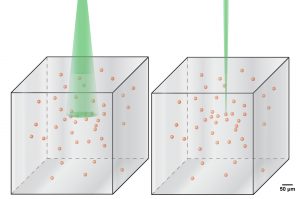 The miniature portable lightweight Raman spectrometer with 532 nm excitation enables unambiguous detection of carotenoids in microscopic inclusions in crystalline laboratory-grown salts – chlorides and sulfates. This is achieved without the use of any microscopic device. The results obtained can serve as a basis for proposing to use portable Raman spectrometers as a tool of first-pass when sampling salt and sulfate crystalline masses for carotenoid analyses in situ at outcrops or drill cores sampling. This report has relevance for search of biomarkers in exobiology context.
The miniature portable lightweight Raman spectrometer with 532 nm excitation enables unambiguous detection of carotenoids in microscopic inclusions in crystalline laboratory-grown salts – chlorides and sulfates. This is achieved without the use of any microscopic device. The results obtained can serve as a basis for proposing to use portable Raman spectrometers as a tool of first-pass when sampling salt and sulfate crystalline masses for carotenoid analyses in situ at outcrops or drill cores sampling. This report has relevance for search of biomarkers in exobiology context.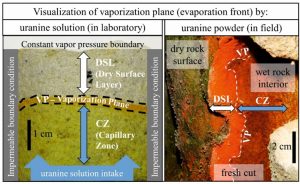 The vaporization plane in porous media separates the region of capillary flow from the dry surface layer, where the water transports in its gas phase. Knowledge of the depth and geometry of the vaporization plane is critical for estimating water flux in the soil-atmosphere interphase, for understanding evaporation processes in general, and for prediction of damaging salt crystallization locations. Use of sodium fluorescein (called also uranine) to visualize the vaporization plane in porous media in both laboratory and field experiments is presented. The property of uranine solution to change its color according to its concentration is used to: i) visualize the vaporization plane by forming a distinctive dark-orange zone where the pore water evaporates, and ii) to distinguish the zone of vapor flow from the zone where capillary flow is present. A complex-shaped vaporization plane in hydrophobic materials is also detectable. Uranine powder, when applied onto a porous material, clearly visualizes the dry surface layer and the capillary zone, divided by the vaporization plane.
The vaporization plane in porous media separates the region of capillary flow from the dry surface layer, where the water transports in its gas phase. Knowledge of the depth and geometry of the vaporization plane is critical for estimating water flux in the soil-atmosphere interphase, for understanding evaporation processes in general, and for prediction of damaging salt crystallization locations. Use of sodium fluorescein (called also uranine) to visualize the vaporization plane in porous media in both laboratory and field experiments is presented. The property of uranine solution to change its color according to its concentration is used to: i) visualize the vaporization plane by forming a distinctive dark-orange zone where the pore water evaporates, and ii) to distinguish the zone of vapor flow from the zone where capillary flow is present. A complex-shaped vaporization plane in hydrophobic materials is also detectable. Uranine powder, when applied onto a porous material, clearly visualizes the dry surface layer and the capillary zone, divided by the vaporization plane. On Tuesday June 12, 2018, Petr Kozlovcev, who is a part-time technician of the Center, defended his PhD entitled “Influence of the mineralogical composition of raw material on phases formed during the burning of hydraulic lime and natural cement”. Congratulations!
On Tuesday June 12, 2018, Petr Kozlovcev, who is a part-time technician of the Center, defended his PhD entitled “Influence of the mineralogical composition of raw material on phases formed during the burning of hydraulic lime and natural cement”. Congratulations!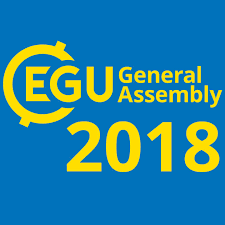 The EGU General Assembly brings together geoscientists from all over the world. This year it took place in Vienna, Austria, from April 8 to 13, 2018. Kateřina Jandová, a junior researcher of Center for Geosphere Dynamics was not only participating in this important meeting with her
The EGU General Assembly brings together geoscientists from all over the world. This year it took place in Vienna, Austria, from April 8 to 13, 2018. Kateřina Jandová, a junior researcher of Center for Geosphere Dynamics was not only participating in this important meeting with her  As a part of a special issue of the university journal Forum dedicated to 670th anniversary of Charles University foundation, Jakub Trubač, a junior researcher of Center for Geosphere Dynamics was interviewed as a representative of Faculty of Science. He starts with the citation of one of his teachers, Dr. Fratišek V. Holub, who said: “Rocks are the only solid basis of our world”:-) Enjoy the interview on pages 52-53 of the electronic document (
As a part of a special issue of the university journal Forum dedicated to 670th anniversary of Charles University foundation, Jakub Trubač, a junior researcher of Center for Geosphere Dynamics was interviewed as a representative of Faculty of Science. He starts with the citation of one of his teachers, Dr. Fratišek V. Holub, who said: “Rocks are the only solid basis of our world”:-) Enjoy the interview on pages 52-53 of the electronic document (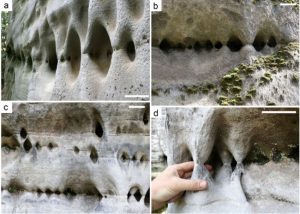 Critical evaluation of hundreds of photos of sandstone and other granular rock outcrops taken in various regions around the world revealed a presence of a specific sub-group of weathering forms related to planar discontinuities, hereby called arcades. The arcades are characterized as pits and cavities varying in size, but similar in shape, coalesced into „trains“ along the discontinuities, and separated from each other by hourglass-shaped pillars. In their origin and geometry, these forms differ from widely known cavernous weathering forms such as honeycombs and tafoni. Using numerical and physical in situ modelling, it has been shown that arcade shape and size are controlled by the redistribution of gravity-induced stress along planar discontinuities and the resulting stress shadow, which is characterized by material loss owing to various weathering and erosional mechanisms.
Critical evaluation of hundreds of photos of sandstone and other granular rock outcrops taken in various regions around the world revealed a presence of a specific sub-group of weathering forms related to planar discontinuities, hereby called arcades. The arcades are characterized as pits and cavities varying in size, but similar in shape, coalesced into „trains“ along the discontinuities, and separated from each other by hourglass-shaped pillars. In their origin and geometry, these forms differ from widely known cavernous weathering forms such as honeycombs and tafoni. Using numerical and physical in situ modelling, it has been shown that arcade shape and size are controlled by the redistribution of gravity-induced stress along planar discontinuities and the resulting stress shadow, which is characterized by material loss owing to various weathering and erosional mechanisms. A combination of multiple techniques including XAS and isotopes helped to decipher the mobility of Tl in mining-polluted desert soil in Namibia. Mechanical transport of fine particles of post-flotation tailings is probably responsible for Tl dispersion in soil profiles.
A combination of multiple techniques including XAS and isotopes helped to decipher the mobility of Tl in mining-polluted desert soil in Namibia. Mechanical transport of fine particles of post-flotation tailings is probably responsible for Tl dispersion in soil profiles.